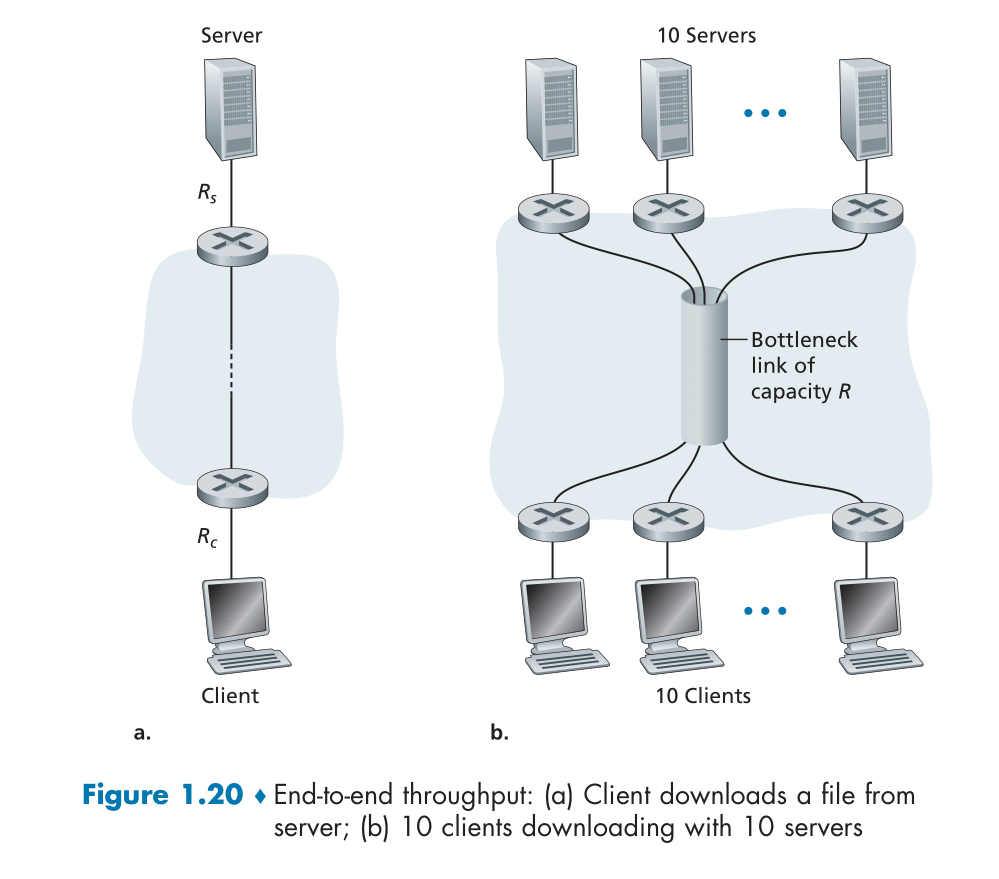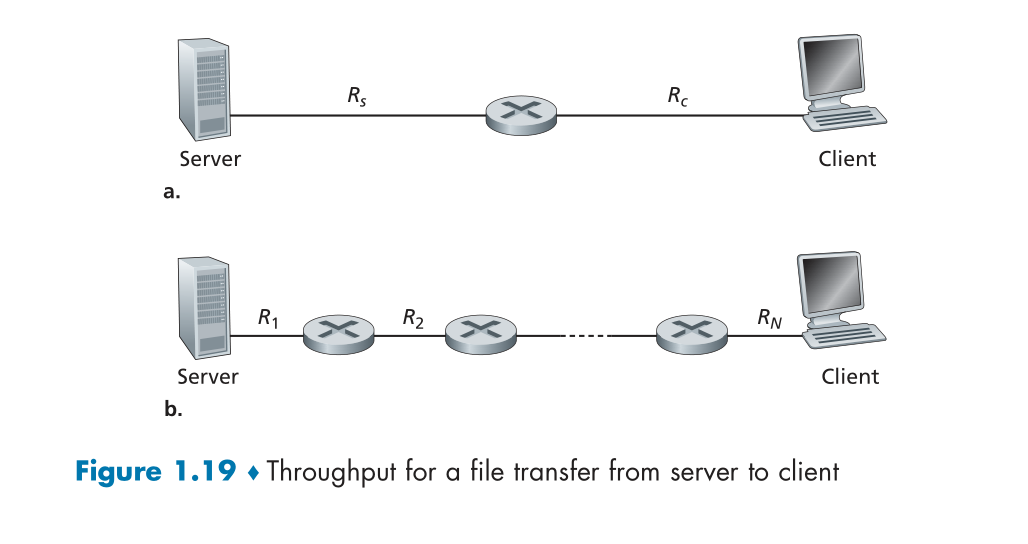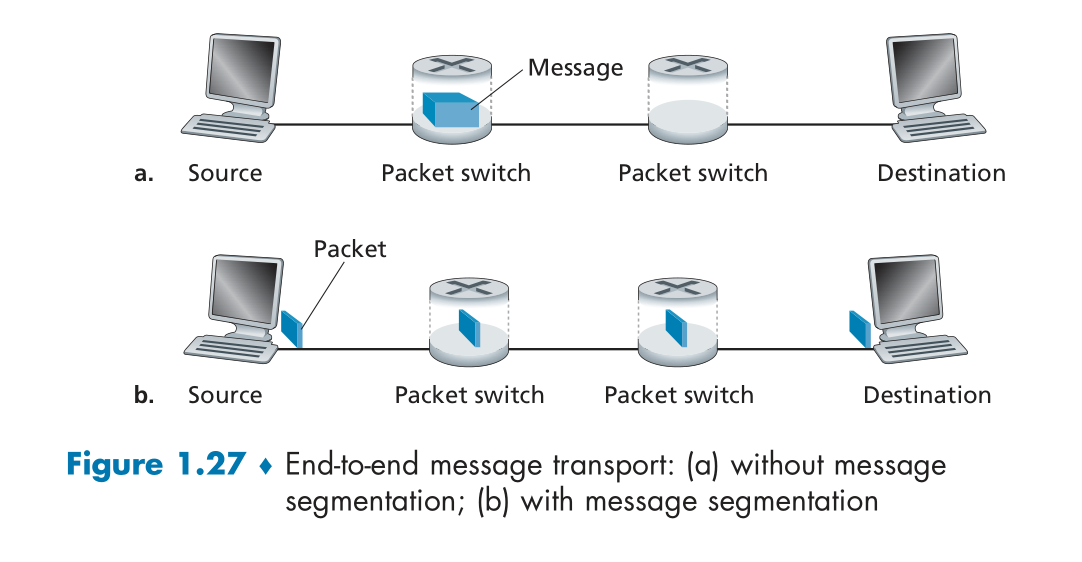复习题
R1.
What is the difference between a host and an end system? List several different types of end systems. Is a Web server an end system?
“主机”和“端系统”之间有什么不同?列举几种不同类型的端系统。Web服务器是一种端系统吗?
- 没有区别。根据书本内容,“主机”和“终端系统”是交换使用的。
- 终端系统包括网络服务器、邮件服务器、工作站、 PC、PDA、连接网络的游戏控制台等等
- 是
R10.
Describe the most popular wireless Internet access technologies today. Compare and contrast them.
描述今天最为流行的无线因特网接入技术。对它们进行比较和对照。
- WiFi,无线局域网,为无线用戶提供无线网服务。无线用户从辐射范围为几十米的基站(例如无线AP)传输数据。
- 4G和5G,大范围无线网,由电信运营商的基站提供几十干米范围内的无线网络。
R11.
Suppose there is exactly one packet switch between a sending host and a receiving host. The transmission rates between the sending host and the switch and between the switch and the receiving host are and
, respectively. Assuming that the switch uses store-and-forward packet switching, what is the total end-to-end delay to send a packet of length L? (Ignore queuing, propagation delay, and processing delay.)
假定在发送主机和接收主机间只有一台分组交换机。发送主机和交换机间以及交换机和接收主机间的传输速率分别是和
。假设该交换机使用存储转发分组交换方式,发送一个长度为 L 的分组的端到端总时延是什么?(忽略排队时延、传播时延和处理时延。)
R13.
Suppose users share a 2 Mbps link. Also suppose each user transmits continuously at 1 Mbps when transmitting, but each user transmits only 20 percent of the time. (See the discussion of statistical multiplexing in Section 1.3.)
- When circuit switching is used, how many users can be supported?
- For the remainder of this problem, suppose packet switching is used. Why will there be essentially no queuing delay before the link if two or fewer users transmit at the same time? Why will there be a queuing delay if three users transmit at the same time?
- Find the probability that a given user is transmitting.
- Suppose now there are three users. Find the probability that at any given time, all three users are transmitting simultaneously. Find the fraction of time during which the queue grows.
假定用户共享一条2Mbps链路。同时假定当每个用户传输时连续以1Mbps传输,但每个用户仅传输20%的时间
- 当使用电路交换时,能够支持多少用户?
- 作为该题的后继问题,假定使用分组交换。为什么如果两个或更少的用户同时传输的话,在链路前面基本上没有排队时延?为什么如果3个用户同时传输的话,将有排队时延?
- 求出某指定用户正在传输的概率。
假定现在有3个用户。求出在任何给定的时间,所有3个用户在同时传输的概率。求出队列增长的时间比率。
每个用户需要一半的链路带宽,可以支持2个
- 由于每个用户在传输时需要 1Mbps,因此,如果两个或更少的用户同时传输,则最大需要2Mbps。由于共享链路的可用带宽为2Mbps,因此在链接之前不会有排队延迟。而如果三个用户同时进行传输,则所需的带宽将为3Mbps,这比共享链路的可用带宽更大。在这种情况下,链接之前会有排队延迟。
- 0.2
- 所有三个用户同时传输的概率 =
;队列在所有用户都在传输时增长,因此队列增长的时间比例等于所有三个用户同时在传输的概率,即 0.008
R18.
How long does it take a packet of length 1,000 bytes to propagate over a link of distance 2,500 km, propagation speed , and transmission rate
? More generally, how long does it take a packet of length
to propagate over a link of distance
, propagation speed
, and transmission rate
bps? Does this delay depend on packet length? Does this delay depend on transmission rate?
一个长度为 1000 字节的分组经距离为 的链路传播,传播速率为
并且传输速率为
,它需要用多长时间?更为一般地,一个长度为
的分组经距离为
的链路传播,传播速率为
并且传输速率为
bps,它需要用多长时间?该时延与包长度有关吗?该时延与传输速率相关吗?
- 10 ms
- 无关
- 无关,题目假设分组已经被推上了通信链路
R19.
Suppose Host A wants to send a large file to Host B. The path from Host A to Host B has three links, of rates .
- Assuming no other traffic in the network, what is the throughput for the file transfer?
- Suppose the file is 4 million bytes. Dividing the file size by the throughput, roughly how long will it take to transfer the file to Host B?
- Repeat (a) and (b), but now with
reduced to 100 kbps.
假定主机 A 要向主机 B 发送一个大文件。从主机 A 到主机 B 的路径上有3段链路,其速率分别为 。
- 假定该网络中没有其他流量,该文件传送的吞吐量是多少?
- 假定该文件为 4 MB。用文件长度除以吞吐量,将该文件传输到主机 B 大致需要多长时间?
重复(a)和(b),只是这时
减小到 100kbps
- 同理,略
R20.
Suppose end system A wants to send a large file to end system B. At a very high level, describe how end system A creates packets from the file. When one of these packets arrives to a router, what information in the packet does the router use to determine the link onto which the packet is forwarded? Why is packet switching in the Internet analogous to driving from one city to another and asking directions along the way?
假定端系统 A 要向端系统 B 发送一个大文件。在一个非常高的层次上,描述端系统怎样从该文件生成分组。当这些分组之一到达某分组交换机时,该交换机使用分组中的什么信息来决定将该分组转发到哪一条链路上?因特网中的分组交换为什么可以与驱车从一个城市到另一个城市并沿途询问方向相类比?
端系统 A 将大文件拆分为多个块。A 通过添加文件头信息至每一个块来从文件生成多个分组。分组的头信息包含目标(端系统 B)IP地址。交换机使用分组的头部信息,查找路由表项,来决定分组应该发往哪一条链路。将分组交换类比为开车从一个城市到另一个城市是因为二者的相似之处都是在开始时都只知道目的地址,但是不知道具体选择哪一条链路;分组的下一条链路的选择是由路由器根据转发表来确定的,而汽车通过询问来选择下一步要走的路。
R23.
What are the five layers in the Internet protocol stack? What are the principal responsibilities of each of these layers?
因特网协议栈中的5个层次有哪些?在这些层次中,每层的主要任务是什么?
5层参考模型综合了 OSl 和 TCP/IP 协议
- 应用层:支持各种网络应用 FTP、SMTP、DNS、HTTP、HTTPS
- 传输层 TCP数据段 UDP数据报:进程-进程的数据传输 TCP、UDP
- 网络层 分组或者包:源主机到目的主机的数据分组路由与转发 IP、ICMP、OSPF等
- 数据链路层 帧:把网络层传下来的数据报组装成帧 Ethernet、PPP
- 物理层:比特传输
习题
P3.
Consider an application that transmits data at a steady rate (for example, the sender generates an N-bit unit of data every k time units, where k is small and fixed). Also, when such an application starts, it will continue running for a relatively long period of time. Answer the following questions, briefly justifying your answer:
- Would a packet-switched network or a circuit-switched network be more appropriate for this application? Why?
- Suppose that a packet-switched network is used and the only traffic in this network comes from such applications as described above. Furthermore, assume that the sum of the application data rates is less than the capacities of each and every link. Is some form of congestion control needed? Why?
考虑一个应用程序以稳定的速率传输数据(例如,发送方每 个时间单元产生一个
比特的数据单元,其中
较小且固定)。另外,当这个应用程序启动时,它将连续运行相当长的一段时间。回答下列问题,简要论证你的回答
- 是分组交换网还是电路交换网更为适合这种应用?为什么?
- 假定使用了分组交换网,并且该网中的所有流量都来自如上所述的这种应用程序。此外,假定该应用程序数据传输速率的总和小于每条链路的各自容量。需要某种形式的拥塞控制吗?为什么?
a. 电路交换更适合这种应用:
- 发送方速率恒定,即发送方不会闲置带宽。
- 发送方速率稳定且没有突发性质的分组,即使用不会超出预置带宽。
- 程序启动后将运行相当长的一段时间,即启动预分配电路和资源的时间被运行时间分摊。
b. 不需要,传输速率总和小于链路容量。最坏的情况下,所有应用程序同时通过一个或多个网络链路进行传输。 但是,由于每个链接都有足够的带宽来处理所有应用程序数据速率的总和,所以不会发生拥塞(几乎没有排队),因此网络不需要拥塞控制机制。
P6.
This elementary problem begins to explore propagation delay and transmission delay, two central concepts in data networking. Consider two hosts, A and B, connected by a single link of rate R bps. Suppose that the two hosts are separated by m meters, and suppose the propagation speed along the link is s meters/sec. Host A is to send a packet of size L bits to Host B.
- Express the propagation delay,
, in terms of m and s.
- Determine the transmission time of the packet,
, in terms of L and R.
- Ignoring processing and queuing delays, obtain an expression for the endto-end delay.
- Suppose Host A begins to transmit the packet at time t = 0. At time
, where is the last bit of the packet?
- Suppose
is greater than
. At time
, where is the first bit of the packet?
- Suppose
is less than
. At time
, where is the first bit of the packet?
- Suppose s = 2.5 # 108, L = 1500 bytes, and R = 10 Mbps. Find the distance m so that
equals
.
这个习题开始探讨传播时延和传输时延,这是数据网络中的两个重要概念。考虑两台主机 A 和 B 由一条速率为 bps的链路相连。假定这两台主机相隔
米,沿该链路的传播速率为
。主机 A 向主机 B 发送长度
比特的分组。
- 用 m 和 s 来表示传播时延
- 用 L 和 R 来确定该分组的传输时间
.
- 忽略处理和排队时延,得出端到端时延的表达式。
- 假定主机 A 在时刻
开始传输该分组。在时刻
,该分组的最后一个比特在什么地方?
- 假定
大于
。在时刻
,该分组的第一个比特在何处?
- 假定
小于
。在时刻
该分组的第一个比特在何处?
假定
,
比特,
kbps。求出使
等于
的距离
。
- 该分组的最后一个比特刚刚被推上链路准备开始传送
- 第一位在链路上被传送了
并且还没有到达B
- 已经到达B
P10.
Consider a packet of length L that begins at end system A and travels over three links to a destination end system. These three links are connected by two packet switches. Let 、
and
denote the length, propagation speed, and the transmission rate of link i, for i = 1, 2, 3. The packet switch delays each packet by dproc. Assuming no queuing delays, in terms of
, and L, what is the total end-to-end delay for the packet? Suppose now the packet is 1,500 bytes, the propagation speed on all three links is
, the transmission rates of all three links are 2.5 Mbps, the packet switch processing delay is 3 msec, the length of the first link is 5,000 km, the length of the second link is 4,000 km, and the length of the last link is 1,000 km. For these values, what is the end-to-end delay?
考虑一个长度为 的分组从端系统 A 开始,经3段链路传送到目的端系统。令
、
和
表示链路
的长度、传播速度和传输速率(
)。该分组交换机对每个分组的时延为
。假定没有 排队时延,用
和
表示,该分组总的端到端时延是什么?现在假定该分组 是1500字节,在所有3条链路上的传播时延是
,所有3条链路的传输速率是 2 Mbps, 分组交换机的处理时延是 3 ms,第一段链路的长度是 5000km,第二段链路的长度是 4000km,并且 最后一段链路的长度是 1000km。对于这些值,该端到端时延为多少?
64 ms
P13.
(a) Suppose N packets arrive simultaneously to a link at which no packets are currently being transmitted or queued. Each packet is of length L and the link has transmission rate R. What is the average queuing delay for the N packets?
(b) Now suppose that N such packets arrive to the link every LN/R seconds. What is the average queuing delay of a packet?
a. 假定有 N 个分组同时到达一条当前没有分组传输或排队的链路。每个分组长为 L, 链路传输速率为R。对 N 个分组而言,其平均排队时延是多少?
b. 现在假定每隔 LN/R 秒有 N 个分组同时到达链路。一个分组的平均排队时延是多少?
a.
第一个分组
第二个分组
第三个分组
第 N 个分组
平均时延
b. 当下一批N个分组到达时,上一批已经传完,平均排队时延不变为
P16.
Consider a router buffer preceding an outbound link. In this problem, you will use Little’s formula, a famous formula from queuing theory. Let N denote the average number of packets in the buffer plus the packet being transmitted. Let a denote the rate of packets arriving at the link. Let d denote the average total delay (i.e., the queuing delay plus the transmission delay) experienced by a packet. Little’s formula is . Suppose that on average, the buffer contains 100 packets, and the average packet queuing delay is 20 msec. The link’s transmission rate is 100 packets/sec. Using Little’s formula, what is the average packet arrival rate, assuming there is no packet loss?
考虑一台路由器缓存前面的一条出链路。在这个习题中,将使用李特尔(Little)公式,这是排队论中的一个著名公式。令 N 表示在缓存中的分组加上被传输的分组的平均数。令 a 表示到达该链路的分组速率。今 d 表示一个分组历经的平均总时延(即排队时延加传输时延)。李特尔公式是.假定该缓存平均包含10个分组,并且平均分组排队时延是10ms。该链路的传输速率是100分组/秒。使用李特尔公式,在没有丢包的情况下,平均分组到达率是多少?
P18.
Perform a Traceroute between source and destination on the same continent at three different hours of the day.
a. Find the average and standard deviation of the round-trip delays at each of the three hours.
b. Find the number of routers in the path at each of the three hours. Did the paths change during any of the hours?
c. Try to identify the number of ISP networks that the Traceroute packets pass through from source to destination. Routers with similar names and/ or similar IP addresses should be considered as part of the same ISP. In your experiments, do the largest delays occur at the peering interfaces between adjacent ISPs?
d. Repeat the above for a source and destination on different continents. Compare the intra-continent and inter-continent results.
在一天的3个不同的小时内,在同一个大陆上的源和目的地之间执行 Traceroute.
- 在这3个小时的每个小时中,求出往返时延的均值和方差。
- 在这3个小时的每个小时中,求出路径上的路由器数量。在这些时段中,该路径发生变化了吗?
- 试图根据源到目的地 Traceroute 分组通过的情况,辨明 ISP 网络的数量。具有类似名字和/或类似的 IP 地址的路由器应当被认为是同一个 ISP 的一部分。在你的实验中,在相邻的 ISP 间的对等接口处出现最大的时延了吗?
- 对位于不同大陆上的源和目的地重复上述内容。比较大陆内部和大陆之间的这些结果。
TODO
P20.
Consider the throughput example corresponding to Figure 1.20(b). Now suppose that there are M client-server pairs rather than 10. Denote for the rates of the server links, client links, and network link. Assume all other links have abundant capacity and that there is no other traffic in the network besides the traffic generated by the M client-server pairs. Derive a general expression for throughput in terms of
, and M.
考虑对应于图 1-20b 吞吐量的例子。现在假定有 M 对客户-服务器而不是10对。用分别表示服务器链路、客户链路和网络链路的速率。假设所有的其他链路都有充足容量,并且除了由这M对 客户-服务器 产生的流量外,网络中没有其他流量。推导出由
和 M 表示的通用吞吐量表达式。

吞吐量为:
P21.
Consider Figure 1.19(b). Now suppose that there are M paths between the server and the client. No two paths share any link. Path consists of N links with transmission rates
. If the server can only use one path to send data to the client, what is the maximum throughput that the server can achieve? If the server can use all M paths to send data, what is the maximum throughput that the server can achieve?
考虑图1-19b。现在假定在服务器和客户之间有 M 条路径。任两条路径都不共享任何链路。路径 由传输速率为
的 N 条链路组成。如果服务器仅能够使用一条路径向客户发送数据,则该服务器能够取得的最大吞吐量是多少?如果该服务器能够使用所有 M 条路径发送数据,则该服务器能够取得的最大吞吐量是多少?

- 仅使用一条:
- 使用所有M条:
P22.
Consider Figure 1.19(b). Suppose that each link between the server and the client has a packet loss probability p, and the packet loss probabilities for these links are independent. What is the probability that a packet (sent by the server) is successfully received by the receiver? If a packet is lost in the path from the server to the client, then the server will re-transmit the packet. On average, how many times will the server re-transmit the packet in order for the client to successfully receive the packet?
考虑图1-19b。假定服务器与客户之间的每条链路的丢包概率为 ,且这些链路的丢包率是独立的。一个(由服务器发送的)分组成功地被接收方收到的概率是多少?如果在从服务器到客户的路径上分组丢失了,则服务器将重传该分组。平均来说,为了使客户成功地接收该分组,服务器将要重传该分组多少次?
N 条链路,一个分组成功被接收方收到的概率是
易知该问题为一个几何分布,客户端所需传输的平均次数为:。所需重传的平均次数
P23.
Consider Figure 1.19(a). Assume that we know the bottleneck link along the path from the server to the client is the first link with rate bits/sec. Suppose we send a pair of packets back to back from the server to the client, and there is no other traffic on this path. Assume each packet of size L bits, and both links have the same propagation delay
.
a. What is the packet inter-arrival time at the destination? That is, how much time elapses from when the last bit of the first packet arrives until the last bit of the second packet arrives?
b. Now assume that the second link is the bottleneck link (i.e., ). Is it possible that the second packet queues at the input queue of the second link? Explain. Now suppose that the server sends the second packet T seconds after sending the first packet. How large must T be to ensure no queuing before the second link? Explain.
考虑图1-19a。假定我们知道沿着从服务器到客户的路径的瓶颈链路是速率为 bps的第一段链路。假定我们从服务器向客户发送紧密相连的一对分组,且沿这条路径没有其他流量。假定每个分组的长度为 L 比特,两条链路具有相同的传播时延
.
- 在目的地,分组的到达间隔时间有多大?也就是说,从第一个分组的最后一个比特到达 到 第二个分组最后一个比特到达所经过的时间有多长?
- 现在假定第二段链路是瓶颈链路(即
)。第二个分组在第二段链路输入队列中排队是可能的吗?请解释原因。现在假定服务器在发送第一个分组
秒之后再发送第二个分组。为确保在第二段链路之前没有排队,
必须要有多长?试解释原因。

a.
第一个分组被推上链路经过了 ,第二个分组被推上链路经过了
此时第一个分组已经传送了 秒,因此最终到达的时间间隔为
秒。
b.
可能,因为第二个分组(用P2表示)可能在第一个分组(P1)被推出之前到达
P1被完全推出的时间
P2 到达路由器的时间
令 则
P25.
Suppose two hosts, A and B, are separated by 20,000 kilometers and are connected by a direct link of R = 2 Mbps. Suppose the propagation speed over the link is meters/sec.
a. Calculate the bandwidth-delay product, .
b. Consider sending a file of 800,000 bits from Host A to Host B. Suppose the file is sent continuously as one large message. What is the maximum number of bits that will be in the link at any given time?
c. Provide an interpretation of the bandwidth-delay product.
d. What is the width (in meters) of a bit in the link? Is it longer than a football field?
e. Derive a general expression for the width of a bit in terms of the propagation speed , the transmission rate
, and the length of the link

假定两台主机 A 和 B 相隔,由一条直接的
的链路相连。假定跨越该链路的传播速率是
.
- 计算时延带宽积
.
- 考虑从主机A到主机B发送一个 800 000 比特的文件。假定该文件作为一个大的报文连续发送。在任何给定的时间,在链路上具有的比特数量最大值是多少?
- 给出带宽 - 时延积的一种解释。
- 在该链路上一个比特的宽度(以米计)是多少?它比一个足球场更长吗?
- 用传播速率
、带宽
和链路
的长度表示,推导出一个比特宽度的一般表示式。
a.
b.
链路上具有的比特数量最大值为
c. 在任何给定时间,链路上的最大比特数量。
d.
每个比特的宽度就是 A-B 之间的距离除以链路上的比特数量
每个比特宽度是 125 米,比一个足球场长。
e.
P27.
Consider problem P25 but now with a link of R = 1 Gbps.
a. Calculate the bandwidth-delay product, .
b. Consider sending a file of 800,000 bits from Host A to Host B. Suppose the file is sent continuously as one big message. What is the maximum number of bits that will be in the link at any given time?
c. What is the width (in meters) of a bit in the link?
考虑习题P25,但此时链路的速率是R=1 Gbps
a. 计算带宽 - 时延积
b. 考虑从主机 A 到主机 B 发送一个 800 000 比特的文件。假定该文件作为一个大的报文连续发送。在任何给定的时间,在链路上具有的比特数量最大值是多少?
c. 在该链路上一个比特的宽度(以米计)是多少?
a.
b
由 可以得知,直到该文件的所有比特位被推上链路,该文件的第一个比特也没有到达目的地,所以链路上具有的比特数量最大值为
比特。
c.
在该链路上一个比特的宽度是
P28.
Refer again to problem P25.
a. How long does it take to send the file, assuming it is sent continuously?
b. Suppose now the file is broken up into 20 packets with each packet containing 40,000 bits. Suppose that each packet is acknowledged by the receiver and the transmission time of an acknowledgment packet is negligible. Finally, assume that the sender cannot send a packet until the preceding one is acknowledged. How long does it take to send the file?
c. Compare the results from (a) and (b).
再次考虑习题P25.
a. 假定连续发送,发送该文件需要多长时间?
b. 假定现在该文件被划分为20个分组,每个分组包含 40 000 比特。假定每个分组被接收方确认,确认分组的传输时间可忽略不计。最后,假定前一个分组被确认后,发送方才能发送分组。发送该文件需要多长时间
c. 比较(a)和(b)的结果。
a.
b.
c.
分组发送而不是连续发送造成了更长的总时延,因为每个分组都引入了自己的传播时延。
P31.
In modern packet-switched networks, including the Internet, the source host segments long, application-layer messages (for example, an image or a music file) into smaller packets and sends the packets into the network. The receiver then reassembles the packets back into the original message. We refer to this process as message segmentation. Figure 1.27 illustrates the end-to-end transport of a message with and without message segmentation. Consider a message that is 106 bits long that is to be sent from source to destination in Figure 1.27. Suppose each link in the figure is 5 Mbps. Ignore propagation, queuing, and processing delays.
a. Consider sending the message from source to destination without message segmentation. How long does it take to move the message from the source host to the first packet switch? Keeping in mind that each switch uses store-and-forward packet switching, what is the total time to move the message from source host to destination host?
b. Now suppose that the message is segmented into 100 packets, with each packet being 10,000 bits long. How long does it take to move the first packet from source host to the first switch? When the first packet is being sent from the first switch to the second switch, the second packet is being sent from the source host to the first switch. At what time will the second packet be fully received at the first switch?
c. How long does it take to move the file from source host to destination host when message segmentation is used? Compare this result with your answer in part (a) and comment.
d. In addition to reducing delay, what are reasons to use message segmentation?
e. Discuss the drawbacks of message segmentation.
在包括因特网的现代分组交换网中,源主机将长应用层报文(如一个图像或音乐文件)分段为较小的分组并向网络发送。接收方则将这些分组重新装配为初始报文。我们称这个过程为报文分段。图1-27显示了一个报文在报文不分段或报文分段情况下的端到端传输。考虑一个长度为比特的报文,它在图1-27中从源发送到目的地。假定在该图中的每段链路是 2Mbps。忽略传播、排队和处理时延。
a. 考虑从源到目的地发送该报文且没有报文分段。从源主机到第一台分组交换机移动报文需要多长时间?记住,每台交换机均使用存储转发分组交换,从源主机移动该报文到目的主机需要多长时间?
b. 现在假定该报文被分段为800个分组,每个分组 10 000 比特长。从源主机移动第一个分组到第台交换机需要多长时间?从第一台交换机发送第一个分组到第二台交换机,从源主机发送第二个分组到第一台交换机各需要多长时间?什么时候第二个分组能被第一台交换机全部收到?
c. 当进行报文分段时,从源主机向目的主机移动该文件需要多长时间?将该结果与(a)的答案进行比较并解释之。
d. 除了减小时延外,使用报文分段还有什么原因?
e. 讨论报文分段的缺点。

a.
从源主机到第一台分组交换机移动报文
从源主机移动该报文到目的主机
b.
从源主机移动第一个分组到第一台交换机需要的时间为 :
第二个分组能被第一台交换机接收到的时间点为 :
c.
t = 15 ms 时第一个分组到达目的主机,此时第二个分组在最后一台分组交换机中
t = 15 + 5 ms 时第二个分组到达目的地
t = 15 + 2 x 5 ms 时第三个分组到达目的地
t = 15 + (N - 1) x 5 ms 时第 N 个分组到达目的地
t = 15 + (800 - 1) x 5 ms = 4.01 s
使用分组的时延比不分组的小,只有不分组的 1/3
d.
- 便于当有某些 bit 位发生错误时,可以重传单独的某个分组而不是整个报文。
- 避免小的数据包需要排在大的数据包后导致的延迟
e.
- 报文分段的每个小分组必须添加首部控制信息,这增加了原本需要传输的总报文的长度
- 分组需要排序,增加了复杂性
P33.
Consider sending a large file of F bits from Host A to Host B. There are three links (and two switches) between A and B, and the links are uncongested (that is, no queuing delays). Host A segments the file into segments of S bits each and adds 80 bits of header to each segment, forming packets of bits. Each link has a transmission rate of
. Find the value of S that minimizes the delay of moving the file from Host A to Host B. Disregard propagation delay.
考虑从主机 A 到主机 B 发送一个 比特的大文件。A 和 B 之间有三段链路(和两台交换机),并且该链路不拥塞(即没有排队时延)。主机A将该文件分为每个为
比特的报文段,并为每个报文段增加一个 80 比特的首部,形成
比特的分组。毎条链路的传输速率为
。求出从 A 到 B 移动该文件时延最小的值 S。忽略传播时延。
第一个分组到达目的地
第二个分组达到目的地
第 N 个分组到达目的地 ,
即
令导数为0,有:

